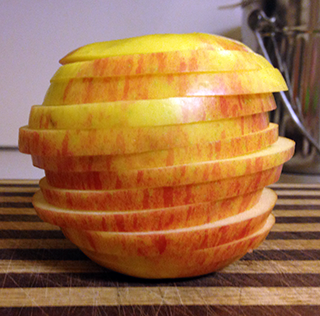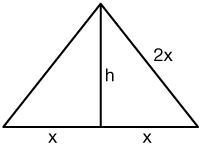Volume of a solid as a sum of volumes of thin slices
The material in this section is closely related to that in the sections on volume of rotation: Disk method, Washer method & Shell method. By slicing a 3-dimensional object into a large number of infinitesimally-thin cross sections, and integrating through the "stack," we can find volumes of quite a few strangely-shaped objects.
In fact, visualizing some of those objects in your head will probably be the trickiest part of integrating by slices. The examples below will help to get you used to thinking about 3-D objects with simple cross sections.

The idea
The basic idea is that if an object can be sliced into an infinite number of infinitesimally thin slices (thinner than these apple slices), and if those slices have a predictable 2-D shape (near circles for the apple), we can add those up by integration to get the volume.
If you wanted to find the volume of a shoebox, for example, you could add up rectangular slices along any one of three different directions, $x, \;y$ or $z$.
In the examples that follow, notice that we're working in 3-D $(x, y, z)$ coordinates.
Example 1
For our first example, let's take a 3-dimensional figure with all right angles, known as a rectangular solid or a rectilinear solid. We already know that the volume of such an object is $\text{length} \times \text{width} \times \text{height}$, $LWH$. Here's the solid with a set of $x$, $y$, $z$ axes drawn in.

The way we'll determine the volume of this object is to note that cross sections perpendicular to the x-axis, like the one in blue, have $\text{area} = h \times w$, and infinitesimal width of $dx$. If we then use the integral along the x-axis as the sum of an infinite number of these rectangles, we get the volume of the box:
$$V = \int_0^l h\cdot w \, dx = hw\cdot x \bigg|_0^l = hwl$$
which matches our expectation of the volume. We could also have found the same result by summing up rectangles in the $x-y$ plane along the $z$-axis or by summing rectangles in the $x-z$ plane along the $y$-axis. You might want to set up those integrals for yourself and make sure you get the same result: $V = h\cdot w\cdot l$.
Example 2
Now let's do a more complicated example. Consider the parabola in the $x-y$ plane, $y=x^2$. We don't need to be concerned about whether this is a proper function; we just need the function to be consistent with the 3-D object it describes. We'll let cross sections perpendicular to the $x$ axis the square. Here's what the figure looks like:

It might take some staring at that figure to get a feel for the shape of the solid object. Its base is our parabola (dark black). It is snub-nosed and square on the end closest to us (at $x=2$), and pointed on the opposite end, at the origin of the axes. Looking at it from the top or sides, it has a curved "spine" running down either side (dashed curves) to a point at the origin.
We have all of the information we need to calculate the area of one of the squares as a function of $x$ or $y$. We start by finding the length of a side of the square as a function of $x$. We use $x$ because it's the direction along which we'll be stacking squares to fill the volume:
$$x = y^2 \; \longrightarrow \; y = \sqrt{x}$$
Now the side of the square is twice that (see the blue notation in the diagram):
$$ \begin{align} \text{side of square} &= 2 \sqrt{x} \\[5pt] \text{area of square} &= (2 \sqrt{x})^2 \end{align}$$
With the area in hand, we now just integrate along the x-axis from the origin ($x=0$) to $x=2$:
$$ \begin{align} V &= \int_0^2 (2 \sqrt{x})^2 \, dx \\[5pt] &= \int_0^2 \, 4x \, dx = 2x^2 \bigg|_0^2 = 8 \; units^3 \end{align}$$
Notice that $x$ was the obvious direction along which to integrate in this example. The cross sections of this object perpendicular to the x-axis can be predictably described using the parabola equation.
Example 3
In this example the base is a circle of radius $r$, centered at the origin $(0, 0, 0)$, with equation $x^2+y^2=r^2$. The cross sections are equilateral triangles with one edge forming a chord across the circle and the vertex of the other two forming a sharp spine along the center of the object (dashed

Now the triangles are stacked up perpendicular to the y-axis, so this time we'll be integrating (which is just summing) along the y-axis between $y = -r$ and $y = r$.
First we need to know the area of one of those triangles. Here's the basic geometry — remember that they're equilateral.

We don't know the value of the height, $h$, but we can relate it to the x-coordinate using the Pythagorean theorem:
![]()
Then by simple algebra, we have:
$$h = \sqrt{3x^2} = x\sqrt{3}$$
Now we're integrating along the y-axis, so we'll want to express h and x (and ultimately the area of each triangle) as a function of y. We begin by rearranging the circle equation:
$$ \begin{align} x^2 + y^2 &= r^2 \\[5pt] x &= ±\sqrt{r^2 - y^2} \end{align}$$
Then the area of our equilateral triangle is twice the area of one of the right triangles:
![]()
After we insert $x$ as a function of $y$, we get
$$A = (r^2 - y^2) \sqrt{3}$$
which we can integrate. Notice that we can simplify the integral by taking advantage of the symmetry of a circle. It's always easier to evaluate a definite integral when one of the limits is zero:

This is a pretty easy integral. Here's how to finish it and evaluate the limits:
$$ \begin{align} &= 2 \sqrt{3} \left(r^2y - \frac{y^3}{3} \right) \bigg|_0^r \\[5pt] &= 2 \sqrt{3} \left(r^3 - \frac{r^3}{3} \right) \\[5pt] &= 2 \sqrt{3} \left(\frac{2r^3}{3} \right) = \frac{4r^3\sqrt{3}}{3} \end{align}$$
In problems like this, when no units are specified, it's a good idea to be in the habit of writing "units3" in the place of actual units. That way, when there are units, you'll be less likely to forget them.

![]()
xaktly.com by Dr. Jeff Cruzan is licensed under a Creative Commons Attribution-NonCommercial-ShareAlike 3.0 Unported License. © 2012-2025, Jeff Cruzan. All text and images on this website not specifically attributed to another source were created by me and I reserve all rights as to their use. Any opinions expressed on this website are entirely mine, and do not necessarily reflect the views of any of my employers. Please feel free to send any questions or comments to jeff.cruzan@verizon.net.